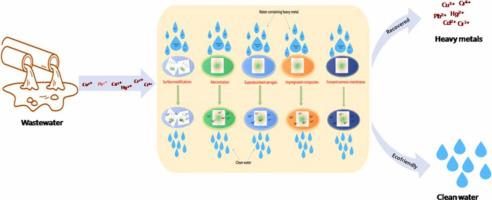Journal of Hazardous Materials ( IF 13.6 ) Pub Date : 2021-10-18 , DOI: 10.1016/j.jhazmat.2021.127516 R Reshmy , Eapen Philip , Aravind Madhavan , Arivalagan Pugazhendhi , Raveendran Sindhu , Ranjna Sirohi , Mukesh Kumar Awasthi , Ashok Pandey , Parameswaran Binod

|
Heavy metal pollution generated by urban and industrial activities has become a major global concern due to its high toxicity, minimal biodegradability, and persistence in the food chain. These are the severe pollutants that have the potential to harm humans and the environment as a whole. Mercury, chromium, copper, zinc, cadmium, lead, and nickel are the most often discharged hazardous heavy metals. Nanocellulose, reminiscent of many other sustainable nanostructured materials, is gaining popularity for application in bioremediation technologies owing to its many unique features and potentials. The adsorption of heavy metals from wastewaters is greatly improved when cellulose dimension is reduced to nanometric levels. For instance, the adsorption efficiency of Cr3+ and Cr6+ is found to be 42.02% and 5.79% respectively using microcellulose, while nanocellulose adsorbed 62.40% of Cr3+ ions and 5.98% of Cr6+ ions from contaminated water. These nanomaterials are promising in terms of their ease and low cost of regeneration. This review addresses the relevance of nanocellulose as biosorbent, scaffold, and membrane in various heavy metal bioremediation, as well as provides insights into the challenges, future prospects, and updates. The methods of designing better nanocellulose biosorbents to improve adsorption efficiency according to contaminant types are focused.
中文翻译:

纳米纤维素作为有害重金属污染物修复的绿色材料
城市和工业活动产生的重金属污染因其高毒性、极低的生物降解性和在食物链中的持久性而成为全球关注的主要问题。这些是有可能危害人类和整个环境的严重污染物。汞、铬、铜、锌、镉、铅和镍是最常排放的有害重金属。纳米纤维素,让人想起许多其他可持续的纳米结构材料,由于其许多独特的特性和潜力,在生物修复技术中的应用越来越受欢迎。当纤维素尺寸减小到纳米级时,废水中重金属的吸附会大大提高。例如,Cr 3+和 Cr 6+的吸附效率发现使用微纤维素分别为 42.02% 和 5.79%,而纳米纤维素从污染水中吸附了 62.40% 的 Cr 3+离子和 5.98% 的 Cr 6+离子。这些纳米材料在易于再生和低成本方面很有前景。本综述探讨了纳米纤维素作为生物吸附剂、支架和膜在各种重金属生物修复中的相关性,并提供了对挑战、未来前景和更新的见解。重点关注根据污染物类型设计更好的纳米纤维素生物吸附剂以提高吸附效率的方法。



























 京公网安备 11010802027423号
京公网安备 11010802027423号